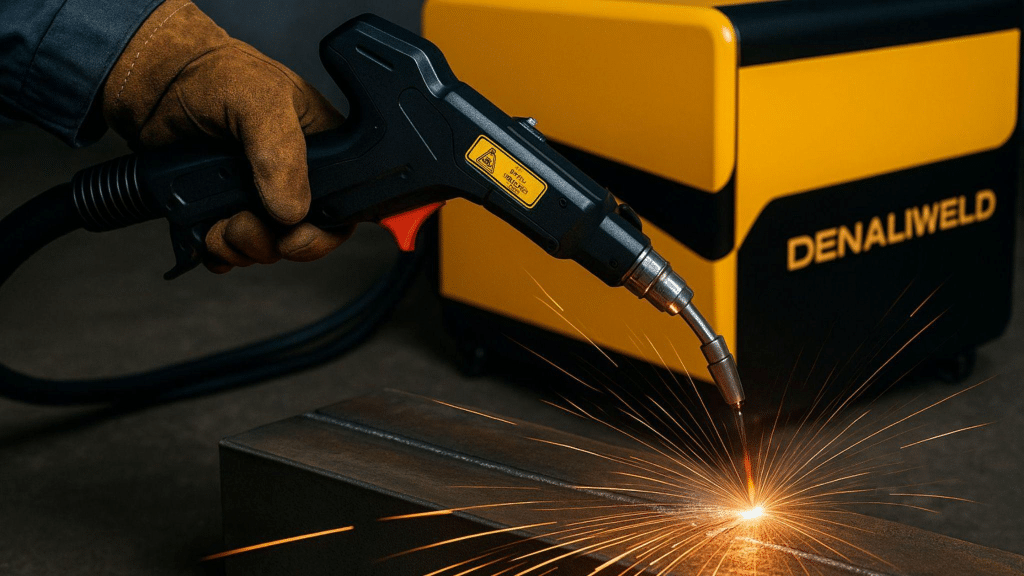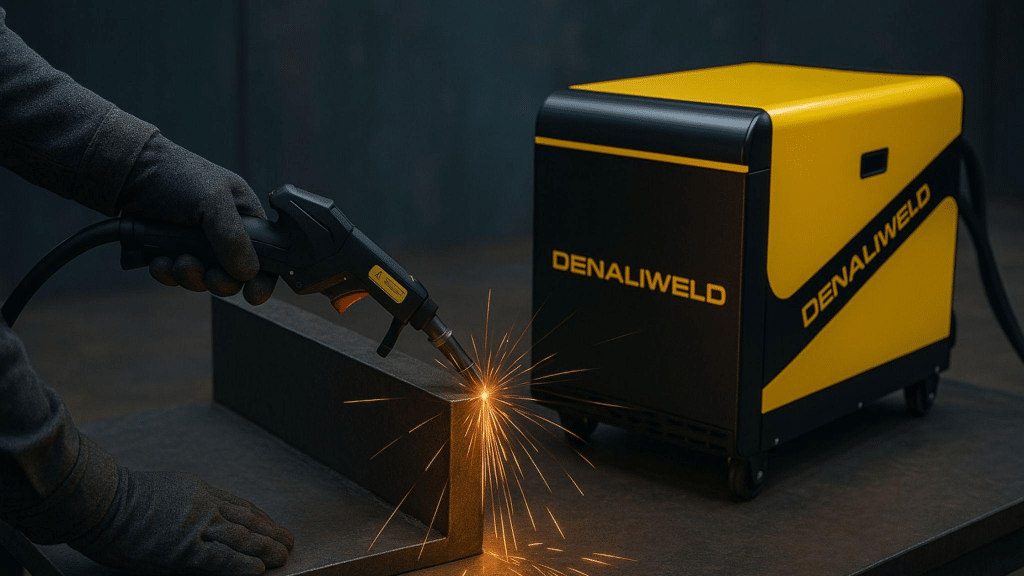Introduction

Welding requires a high-power heat source to fuse workpieces. Amongst various options available today, fiber lasers are one of the fastest and most precise.
For this reason, fiber laser welding has gained prominence across modern industries such as automotive, aerospace, and manufacturing.
Can fiber laser welding propel your production speed and efficiency? Read on as we discuss this innovative welding technique and its vast applications.
What is Fiber Laser Welding and How Does It Work?
Fiber laser welding uses optical fibers doped with rare-earth elements like ytterbium to convert light into laser beams. The laser diodes convert electrical energy into light, then a coupler combines the light generated by the diodes to form a coherent and intense beam of light.
The concentrated beam is then focused onto the workpiece and melts metal with an average penetration speed of 0.8 inch per second. The workpieces are then fused on cooling.
Why Fiber Laser Welding is a Game-Changer for Modern Manufacturing
Many manufacturers realized the impact of fiber laser welding on their daily operations. Its unmatched precision and efficiency over traditional methods make it an optimal choice to streamline production processes.
Here are some reasons why firms choose fiber laser welding.
Impressive Material Versatility
The ultra-precise beams of fiber laser welding keep a minimal heat-affected zone on the workpieces. Hence, it is easily applicable both with thick and thin metals, non-metals, thermoplastics, and even organic compounds.
Fiber laser welding also supports the fusion of dissimilar metal workpieces because of its controlled heat input that prevents metallurgical issues and thermal distortion.
High-Level Precision
Manufacturers in the electronics, medical, aerospace, and jewelry industries make tiny parts that need meticulous welding to keep quality high. Amongst welding techniques, fiber laser welding is the one with the highest precision at a micro level which is crucial for the aforementioned industries.
Moreover, most fiber laser welding machines are designed to focus and melt only specific portions of a workpiece. So, using this welding technique translates to a small heat-affected zone which means more consistent and cleaner welds.
Easy-To-Use
Unlike traditional methods with a steep learning curve to master, fiber laser welding is more beginner-friendly. A fiber laser welding machine typically has an intuitive interface or control that enables quick and easy adjustment of laser power, speed, and focus. Hence, an employee with zero experience can be proficient with this welding technique after a few training sessions.
Eco-Friendly Welding Approach
Compared to old-fashioned techniques like TIG and MIG, fiber laser welding emits less waste and by-products because of its efficient heat input. This welding technique also does not use filler materials, so it leads to less pollution to the environment.
Fiber Laser Welding vs. Traditional Welding: Which One is Right for You?

Traditional welding had been manufacturers’ go-to approach to fuse metals. But with a faster, cleaner, and more efficient alternative, it is reasonable to ditch the old-school welding method.
Check out below how fiber laser welding outperforms traditional welding.
Superior Weld Strength
While MIG and TIG are reliable welding methods, they often produce coarse-grain microstructure because of their limited power input. Thus, MIG and TIG joints are typically vulnerable to cracking or material defects when under stress.
Meanwhile, fiber laser welding’s highly concentrated beams are strong enough to create localized heat-affected zones with fine-grain microstructure. This results in stronger welds that can withstand stress over time.
Cutting-Edge Speed and Efficiency
Estimates indicate that fiber laser welding is about three to ten times faster than the traditional methods because of its highly concentrated beam and high power input.
And since fiber laser welding ensures minimal thermal distortion, manufacturers may not perform post-welding clean-ups, which speeds up the production process.
Lower Maintenance and Operational Costs
Even with minimal maintenance, a fiber laser welding machine can operate long-term with consistent performance. It only requires regular cleaning and software updates to ensure it is in good shape.
And since fiber laser welding can fast-track the production process with its impressive penetration speed and accuracy, it drives down the manufacturer’s operational and labor costs over time.
Best Applications for Fiber Laser Welding
The impressive accuracy, speed, and strength of fiber laser welding make it an ideal choice for many manufacturers in these industries.
Automotive: Fiber laser welding aids in the production of engine components, transmission parts, gears, and fuel injector nozzles. It can also effectively combine steel panels in the car body, roof, or hood.
Electronics: Highly reliable in welding small, intricate pieces such as microchips, connectors, and sensors. It can also assemble metal compact components in smartphones, tablets, and computers with minimal thermal distortion.
Aerospace: Weld turbine blades, combustion chambers, and other structures that require strong and precise joints to enhance the aircraft’s safety and performance.
Medical Device and Equipment: Due to its capability to fuse workpieces with minimal contamination and defects, fiber laser welding is crucial to the construction of various medical tools like surgical equipment, endoscopies, dental implants, orthopedic devices, and steel prosthetics.
Choosing the Right Fiber Laser Welding Machine for Your Business

The ideal fiber laser welding machine must have optimal power output, reliable cooling methods, and innovative automation features.
Consider Denaliweld’s Water-Cooled Fiber Laser Welding Machine. It delivers exceptional performance through its cutting-edge functionalities such as:
- High Power Output: Generates up to 3000W of continuous laser output for consistent and efficient performance across a range of industrial applications.
- Modular Cooling System:A water-cooled machine that features a modular design for easy maintenance and repair.
- Intuitive Controls: Adjust laser parameters with ease through one-click operation for quick setup time and welding process.
- Heavy-duty Reliable Performance: Works well even in environments under extreme conditions. It can operate consistently within the range -10°C to 40°C (14°F to 104°F).
Supercharge Production and Manufacturing Through Fiber Laser Welding Technology
Excellent strength, speed, efficiency, and versatility – it is high time to consider fiber laser welding to optimize business operations. As firms strive to deliver high-quality products, this innovative welding technique is one of the keys to being on top.
For top-quality laser welding machines, go to Denaliweld and choose from our series of CE and SSG-certified laser welding machines formulated by esteemed professionals in the industry. Our products feature high power input and pinpoint precision with adjustable parameters for optimal results and maximum ROI.



